The 2000 census data counted only 806 residents, a 6% decline from the 1990 count. 64% white, 28% black, 4% Asian and 2% Hispanic/Latino. The were 1,050 housing units, 65% occupied, 99% of which were rented. The decade from 2000-2010 was transformational for DT where a ~3X increase of residents occurred where now 3,721 people call DT home. Cheers to DT!!! Racial shifts occurred as well in the 2010 Census count: 54% white, 37% black, 5% Asian, 3% Hispanic/Latino. Downtown used to be a ghost town after business hours, but the influx of residents has made this a true neighborhood, and there are people walking around at all hours now, it's good to see. If downtown is to continue it's renaissance, more residents are required. We need to cater to St. Louisan's now instead of trying to cater only to tourists and daytime commuters as the city administrations have done for the past 50 years.
Downtown truly is the door step of the city. It's our face to the world. Ask someone about St. Louis and they'll probably say St. Louie...yeah, the Arch. For better or worse, DT defines the St. Louis metropolitan region as a whole. The DT experience is the St. Louis experience for many, if not most suburbanites, regional visitors, tourists and even some citizens of St. Louis. It's a fact that many in the region refer to the entire City of St. Louis as "Downtown"...so the stakes are high. A vibrant DT means a vibrant STL to most. A 3X gain of residents in Kings Oak will not have nearly the same impact as a similar gain in DT would...and for that, I'm optimistic for St. Louis' future for first impressions, etc. The historic tax credits have largely made this boost in residents happen, that and the growing trend of people wanting to live in cities. In spite of the cities free wheelin' issuance of demolition permits and lust for parking lots, many vacant warehouse, office and factory buildings have been transformed to lofts, apartments, condos, new office/retail space, etc. It's been an amazing transformation to witness. DT was dead in the 1980's. When I moved here in 1994, it was gritty and vacant and starkly surreal, like a mothballed outdoor museum for cool buildings. Now it's everything from gritty to swanky...yet still cool. It's been a damn good 20 years for DT St. Louis. Despite all the job and tax base poaching that Clayton, Missouri and other cities in the suburbs have done to St. Louis over the last 50 years, DT is still the Central Business District and must continue to lure business, jobs and residents if it's to stay on it upward trend.
Holy cow, where do I begin? This neighborhood challenged me to keep the # of photos under 200....a good problem to have, as Downtown St. Louis is highly attractive. You can take a picture of nearly every building along Washington, Locust and Olive, the heart of Downtown. Many think of Market Street as the premier street DT, and that's not a bad argument with City Garden, Kiener Plaza, the Old Courthouse, the beautiful Gateway Greening sponsored plantings, etc. Washington Avenue has arrived as a destination point and a popular place to live. But, I'll put my money on Locust and/or Olive Street with their intersecting numeric streets as the rising stars in the bright future of DT. These two streets are teeming with potential, especially right around the Old Post Office area.
DT also challenged me more than almost any to keep my mouth shut about the negatives. But, I decided to tune down the editorial filter and let a little more of my opinion get into this piece. So forgive me in advance if some anti-parking lot and demolition commentary are sprinkled into this lengthy post. DT is worth talking about the good, the bad and the ugly for a couple reasons: 1. DT is the most important part of our city, it's our heart; it can/should be the central business district (not Clayton, Missouri) 2. It is the best and worst of what our history has brought us...it's simply the single most important and discussion worthy talking point re: STL.
You may notice there is not a lot of fancy or artistic photography of the Arch, Busch Stadium-III or City Garden. I've tried man, and the stuff I'm proud of is personal and not for the interwebs. And, it's been done so much better than I could ever do, so what I've tried to do with those landmarks is just show what they look like from the surrounding streets....give the perspective of the walker/driver passing by on the streets.
Downtown St. Louis is a true beauty. Anyone that doesn't recognize this is off their rocker. Go to any other rust belt U.S. city, or any other city for that matter and tell me our DT isn't as beautiful as those. It is. Even with all it's insane lack of planning and leadership, excessive parking lots and endless catering to the commuter vs. the resident/citizen; it's still got the bones and makings of a very special place. Our forefathers built it to last, and you can still tell; it's just that a lot has changed since the city was a bustling place with street cars, shopping and commerce and people everywhere. But the good news is, people are moving back. And that alone is the primary thing that will make DT the vibrant place people want to see...other people who are there 24/7 and invested. We need more residents than Ball Park Villages, Bottle Districts, etc that cater to visitors. In many ways, DT is a microcosm of all things that truly embody St. Louis as a city. It's the good, the bad and the ugly. I'll do my best to show and talk about all three.
Let's start on the south side of the neighborhood between I-64 and Chouteau. The south eastern part near the river is referred to as Chouteau's Landing and it has amazing potential. Redevelopment ideas posed to date include an artist community with studios and loft dwellings. Another potential boon recently discussed for the south side of DT was the Arch competition that carefully proposed better connections between the Jefferson National Expansion Park and Arch grounds, but that plan will be scaled back and the logical and creative connections are likely not going to happen. This missed opportunity and lack of city leadership in the area of urban planning means the odds will continue to be stacked against Chouteau's Landing. This part of St. Louis is not a priority for the city, and has been sadly neglected since I've lived here. In the eyes of casual passers by on the Poplar Street Bridge (the highest traffic volume bridge between STL and Illinois) it is pretty much an eye sore and a high profile embarrassment. The thing is, the buildings in Chouteau's Landing are amazingly cool right around the Mississippi River. The area has huge potential but many of the buildings are covered in graffiti and abandoned and look pretty desolate from the highways...and the fact remains, this is how people judge us. Again, I'm one of those who thinks this is a really cool place, but the city's negligence can be overwhelming and tilt the scales to the negative pretty quickly. Anyhow, here are some sights of CL, you be the judge:
Public art can move mountains...or mountans
Mom always said there's no such thing as a free meal...but it never hurts to challenge conventional wisdom
We've got to make this part of DT and our city a priority before the firebugs and squatters burn the whole damn thing down and a part of our American industrial history is permanently erased once again.If you are a fan of iron train trestles, you've got to explore Chouteau's Landing. There are many vantage points to get up close and personal with both passenger and freight trains:
There is something hypnotic and gritty and cool about hearing coal and grain role by overhead on these elevated tracks on walks to the baseball game. It's part of the city experience.
Another strong presence on the south side of DT is Purina, with it's familiar "checkerboard square" logo. The Ralston division of Nestle is headquartered in DT. The buildings are highly recognizable on the STL skyline throughout many parts of the city. This company has a long and rich tradition in St. Louis dating back to 1894 when it was founded by William H. Danforth. Purina entered into a merger agreement with Swiss firm Nestle back in 2001, but seems committed to STL as the campus is currently adding on a new building. In 1994, the Ralston human food operations of the Ralston Purina Company were spun off into a new company called Ralcorp Holdings. They also call DT home.
new construction on the Ralston campus
Very few modern corporate campuses are without surface parking lots. This one at least has great views of DT's skyscrapers.
Heading north along the Mississippi Riverfront is another abandoned, neglected mess. Sorry, it's true. The riverfront was once the key economic engine of St. Louis. It no longer is, and now we're left with a completely dead zone. I realize riverboats are no longer used and important to modern life/business. But can't we get some kind of historic remembrance of those days? It doesn't have to be cheezy, it doesn't have to be open, just a damn steamboat down there for Pete's sake. When I was a kid, there were at least things to do down here. There was a retired U.S. destroyer that you could tour, a casino in the former (insanely cool art deco Admiral (recently shuttered, destroyed and sold for scrap metal), a kitschy McDonald's on a faux riverboat (McBarge), and dinner cruises and other touristy things that this Belleville and other suburban kids thought was cool. Now there is nothing outside of maybe a helicopter deck. It's purposefully dead on the riverfront. Sadly, this is what tourists will remember about their exit ramp to see the Arch and St. Louis. A missed opportunity for sure. Here's what it looks like today:
Despite all the current day failures, you can't deny the power of the river and the potential that it holds as a place to visit and be and behold. There is soul in the hobby/scrapper fisherman that drink/fish for cat and buffalo along the banks and the Lewis and Clark (and Seaman) water gauge and monument just south of the Eads Bridge:
The bridges that span the Mississippi River between St. Louis and Illinois are enchanting. Minus the Bernard F. Dickman or as everyone in the area refers to as the Poplar Street Bridge or simply the PSB represents 1967 engineering ideals and the current American desire for only function and no form or beauty. No coffee table books on the ole PSB. This is as boring as a bridge can be. It piques no interest or second look on any level. The PSB embodies much of the St. Louis inferiority complex in that it's the most traveled, highest traffic volume bridge, and clearly the most boring. This kind of thinking brings us the countless demos of historic buildings for modern conveniences of not idling the family truckster and parking mere feet from your destination. The PSB:
The overwhelmingly good thing is, we have several other gorgeous, elegant bridges that span the greatest river in North America. The grandaddy of them all, the preeminent American bridge, the Eads Bridge is a work of art and function. This marvel of engineering and art and creativity and forward thinking has been in operation since 1874. It is all that is great about St. Louis and America. It currently accommodates pedestrian, auto and Metrolink traffic. It is one of the most beautiful bridges anywhere in America. If you consider yourself a St. Louisian, you need to walk the deck of the bridge and take in the River, the strange images of neglect and big ticket hope that is the East St. Louis casino'd expanse and the sweeping, fantastic skyline of St. Louis.
The MacArthur train bridge just south of the PSB took 10 years to build and opened to automobile surface traffic in 1917. It was swapped with the Eads by the Terminal Railroad Association in 1989 to usher in the newest era for Eads and MacArthur. Thanks to our early 20th century forefathers for thinking about beauty as well as function. These structures add to our landscape and make St. Louis a place not just a fly through/over zone:

The Dr. Martin Luther King Jr. Bridge (formerly Veteran's Bridge) was built in 1951 and once carried the U.S. Mother Road Route 66 through St. Louis. So did the Chain of Rocks bridge in the Riverview Neighborhood of St. Louis. It's a great example of a cantilever truss bridge:
And one more magnificent addition is on its way in 2015:
The footings and approaches of this new bridge that will re-route I-70 off the PSB and through DT are taking shape as of this post. Hopefully this bridge will be lit and will provide another gem to our skyline and bring some development into the north side of St. Louis.
Just west of the riverfront is the Arch and Laclede's Landing: a destination for visitors, but sadly not a frequent stop for locals. At least, I know of very St. Louisan's who say "hey, meet me down at the landing"!
The Arch grounds are rarely a draw for locals save for the occasional jogger, a July 4th celebration and a handful of summer concerts. Since October, 1965 it's become St. Louis' greatest symbol. It's grounds and surroundings could be a true asset to the residents of DT and the citizens of St. Louis if it were more connected to the rest of the neighborhood/city. However, the Arch grounds are a disaster to get to on foot and the access points are clumsy and dangerous. The elevated interstate highway lanes are an ominous obstacle for anyone living or visiting downtown.
Nonetheless, the Arch is a striking testament to public art and engineering feats and a strong mid-century America hellbent on modernism. It's the first thing most people think of when they think of St. Louis...the Cardinals might be next...
Although Laclede's Landing is not a local draw, it certainly is a tourist/visitor draw. And frankly, it's a great little spot with cobblestone streets, beautiful buildings, mature street trees and dim street lights that all come together to make it a charming enough tourist spot. The MLK and Eads Bridges frame the area quite nicely and the Mississippi River provides a quiet backdrop. Sadly, with the closing of Mississippi Nights, there's really no reason for most locals to go down there. I would love to go to Morgan Street Brewery more often, but it's a logistical nightmare for locals to get down there. It doesn't have to be this way as its St. Louis architecture in and out:
Legendary St. Louis rapper Nelly has teamed up with Vatterott College to open the Extreme Institute, a 9000 sq ft recording acedemy to teach students all facets of the recording industry. Fantastic, congrats to Nelly for his continued support of his hometown.
One of the newest additions to Laclede's Landing is the Laumier Casino. This sleek, modern high rise can be seen throughout the region. There is a LED lighted strip that lines the building in a lucky 7 shape that illuminates the night and adds to the vibrancy of DT, many refer to it as the glow-hawk.
Downtown is well connected to the Metrolink light rail transit system of St. Louis. It has 4 stops in DT including the Arch/Laclede's Landing, the America's Center (convention/Rams stadium), 8th and Pine and the Cardinals stadium. My favorite stops on the entire line are the Convention Center and 8th and Pine underground stops. It's very big city to run down the stairs and hop on the train. Here's whatthe Cenvention Center stop looks like from the street:
Do you like professional sports? Why not walk or ride the Metrolink to Busch Stadium-III or the Edward Jones Dome to watch the 2011 World Champion St. Louis Cardinals or the St. Louis Rams who both call Dowtown home. (The Blues play hockey in the Downtown West neighborhood).
The Edward Jones Dome is connected to the America's Center convention complex. It skirts the north end of DT.
The St. Louis Cardinals also call DT home and currently play in Busch Stadium-III built in 2006. The Cardinals have won 2 World Series pennants in the new stadium. The Cardinals #1 rival, the Chicago Cubs have yet to win a pennant in their new stadium Wrigley Field...they started playing there in 1916. Sorry, I had to point that out. The Cardinals are the biggest sports draw in the region. They are wildly popular and most St. Louisan's have baseball in their blood. I am no different, the warm sound of baseball coming through an A.M. radio tuned to KMOX in the summer is among my fondest memories. People love baseball here...it goes without saying. Here's the current home of the Cards:
Looks like we need to add 2011...Woo Hoo!
The stadium is nice enough, although Busch-II was just fine as well. The bummer is the Cardinals current ownership has done little to nothing to spur development in the immediate surrounding areas of the stadium. It is an utter dead zone devoid of any possible street life on a non home game (meaning 284 days per year). The Cards have made many promises to date, but have delivered on none of them.
Just to the north of Busch-III is what the ownership of the Cardinals called "Ball Park Village", it was billed as a mixed use development to help sell the city and fans and residents on public subsidies and demolition of the perfectly fine Busch-II. Of course, the Cardinals didn't promise on their commitments to St. Louis and have hemmed and hawed on why they haven't built ballpark village all the while making tons of money. Here's what the current site looks like, the current ownership's thank you note to the city and its 3 million annual loyal fans who even in a down economy support the team in droves:
Not only has the millionaire ownership group denied St. Louis it's promises of BPV, it has left us, the residents and lovers of St. Louis with a surface parking lot, a mosquito pit of a property with half-assed softball fields which no one can use because it's surrounded by cheap hurricane fence. The current Cards ownership group also let the bowling hall of fame go to pot and pack up for all places of Arlington, TX. The St. Louis region was once a power house of bowling. Here's current president of the Texas bowling hall of fame and majority owner Bill DeWitt's words on the issue:
The former HOF still sits empty:“It was difficult passing on the opportunity to be a part of Ballpark Village, especially because the Cardinals and Cordish Companies are innovative companies with proven track records. We are confident that Ballpark Village will be a great success and an important part of downtown St. Louis.”said Pat Ciniello, president of the International Bowling Museum/Hall of Fame.
“We’re very grateful to the International Bowling Museum and Hall of Fame for being a wonderful neighbor and partner throughout the years. We wish them well in Arlington,” said St. Louis Cardinals President Bill DeWitt III. “As for Ballpark Village, this acquisition completes our land assembly process, and represents another key milestone for the project.” (source)
The Cards are such a great part of the city's history, but they could be so much better corporate partners with the city in general in current times. The area surrounding the ballpark is a complete dead zone. Nothing but surface parking and parking garages that suck the soul and life from the neighborhood. Wrigley Ville, Fenway this is not. I wish it were a better experience around the ballpark but you'd be lying if you didn't call a spade a spade. There are a handful of bars around the stadium, but they sit among acres of parking:
There are some fantastic examples of historic reuse and urban transport just west of the stadium in the Cupple's Warehouse area, but much of it lies in wait for reuse and is under imminent threat of collapse from ownership neglect and city ambivalence and lack of drive. The rehabs that have occured in Cupples Station are perfect backdrops for the stadium setting to the west of the metrolink stop:
Another gem of a building is the art deco Tums factory, just east of the ballpark. This is one of my favorites in the entire city:
Another prominent building just east of the ballpark is the curious example of Brutalism architecture in the former PET milk headquarters, now apartments, built in 1969:
The west side of Downtown lines Tucker Boulevard, or 12th Street. The court houses in the western edge of DT are prominent fixtures on the skyline:
Tucker has been closed just north of Washington Avenue for many years. The bridge is being rebuilt and will be an important connector to the new Mississippi River Bridge.
Here are some of the buildings along Tucker:
This beauty above is a city parking garage and firehouse.
^This eye sore was ANOTHER parking garage ushered in by no other than the City of St. Louis right across the street from the other parking garage. Why? No one knows. There are boarded up bays at street level that were billed as potential retail sites, but that never happened.There is an overwhelming glut of parking lots and garages downtown that sucks the life from the town and makes for inconsistent, iratic streets and walkways. I won't go on and on about this, but it's a serious failure on the part of the city. No planning or zoning gets you this. And it sucks and we continue to PAY the price.
Now, there is a parking garage near Macy's that I admire for the ramps:
Okay, you get it. I've made my points about excessive parking lots and mindless destruction of historic buildings for more parking lots. The overwhelmingly good news is, Downtown St. Louis has some of the greatest turn of the century building stock in the whole nation. It's coming back to life and there are businesses popping up that cater to residents not just tourists. The opening of Schnucks Culinaria grocery store was huge. A book store, a bowling alley, a bike store, a revamped Macy's all add to the neighborhood. There are countless restaurants, bars and night clubs. There's a lot going on and it's a fun place to be.
There are details and nuance on nearly every building:
Market is the center street of St. Louis and there are some really cool sites along here including the amazing City Garden, a welcomed addition that is not only a visitor/tourist draw but a fantastic space that residents and citizens of St. Louis go to enjoy the art and landscape. The water features are whimsical and draw kids from all over the city to splash and play in the summer months. It's really a special place. The pictures don't do it justice.
The Gateway Mall, the stretch of "green space" along Market was created to bring some nature and park space to the city's core. It kind of succeeds, and the City Garden certainly does, but the block immediately west of City Garden was reserved for a big steel panel triangle sculpture called "Twain" by renowned artist Richard Serra. It's a love/hate thing. I would love it at Laumier Sculpture park (an expansive suburban outdoor sculpture park) but I hate it hear. It's creates nothing but a dead zone in what could be a great place.
Some other familiar sights along Market through DT:
The Wainwright Building is a must see and is in my personal Top 10 St. Louis buildings. It's at 709 Chestnut and is a stunning masterpiece:
The Wainwright Building is among the first skyscrapers in the world. It was designed by Dankmar Adler and Louis Sullivan in the Palazzo style and built between 1890 and 1891.[3] It was named for local brewer, building contractor, and financier Ellis Wainwright (source)Hey, I'm not alone in my love for this place, here's what Frank Lloyd Wright had to say: "the (Wainwright Building is the) very first human expression of a tall steel office-building as Architecture." Not too bad, eh?
Today this treasure stands proudly in the shadow of City Garden.
And this elegant building feels like the perfect segue way to the other classics downtown.
Here are some general shots of the street scenes and buildings in the heart of DT along Locust, Olive and Washington:
The area around the Old Post Office is among the coolest in town.
Big city for sure:
There's more where that came from...I could go on and on...and there's much that I missed or didn't include here. The upside potential of DT is amazing, go check it out for yourself!



























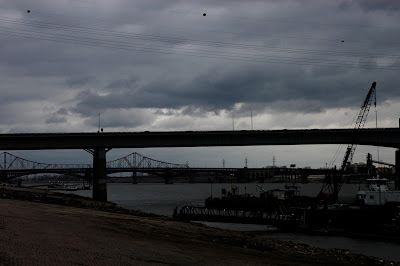










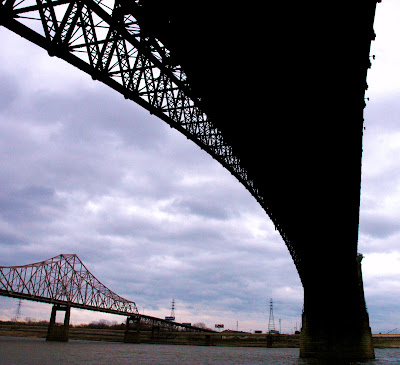
















































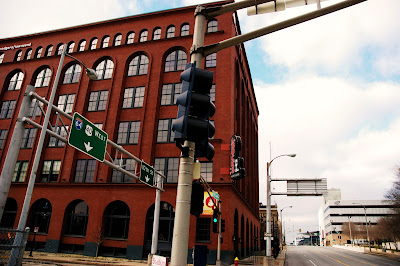















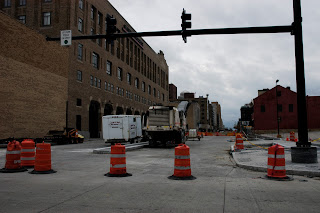












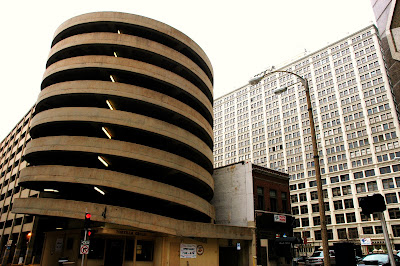





































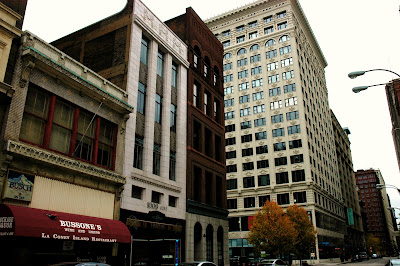


































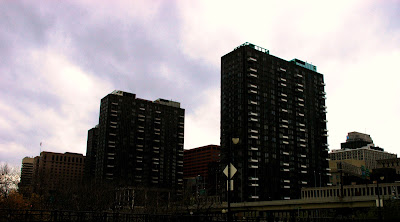

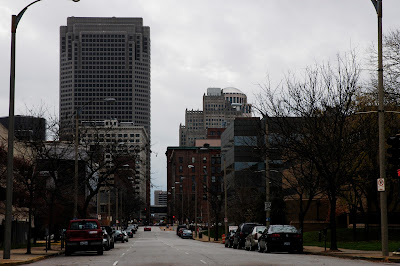












This comment has been removed by the author.
ReplyDeleteUnfortunately, if I understand correctly, they can no longer moor boats in the vicinity of Eads Bridge due to the tricky currents that have caused, on occasion, barges to break loose and knock other boats from their moorings and crash into the pilings for the PSB etc. There were som seriously deadly close calls over the past couple decades. I really lament the loss of all those boats along Wharf (LKSBlvd) Street.
ReplyDeleteGreat post on Downtown. I think this is the final Groth Guide, so congratulations! Couldn't agree more about the riverfront and the missed opportunity. Even with all these pictures, you've left quite a bit left to explore, especially the Wash Avenue entertainment area. That's a good thing as I understand it - these guides are not intended to replace a visit, but to pique interest.
ReplyDeleteBTW - I think you misspelled Lumiere...;)
I am really impressed by your site and blog. Did you take all of the pctures? Can I link your site to StLouis.org? I am just getting started, but your blog certainly contains a lot of history of St. Louis. I have lived here all my life by the way, from North County, Riverview / Ferguson area.
ReplyDelete- Michael
The river is dead to the city and has been since the end of the civil war. I love this town but don't think it will ever be properly integrated into the city again.
ReplyDeleteSTL downtown has some amazing architecture. World class even. Sadly so much of it has disappeared in the last 50 years to placate modern ideals such as car parks and as a result of vacancy.
As always... great post.
1950-1970 was the best time to be downtown; jazz on the riverfront boats and in nite spots; grande movie houses; live theatre; the many restaurants and shopping areas. Then slowly we lost all that; and then came the last straw - the 'mall.' WISH WE COULD GO BACK TO ANY OF THAT.
ReplyDeleteSharon
The MetroLink stop pictured is Convention Center, not 8th & Pine.
ReplyDelete^anonymous July 1, thanks, I corrected it.
ReplyDelete